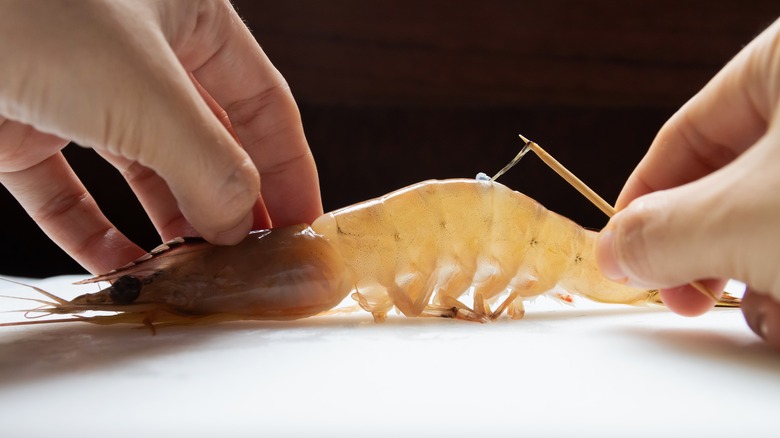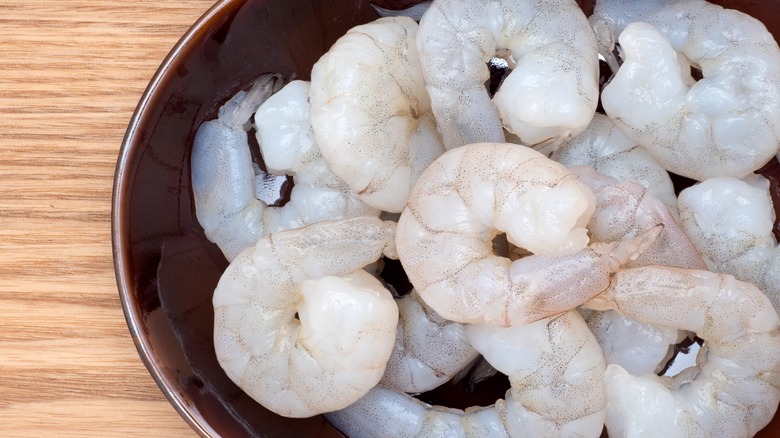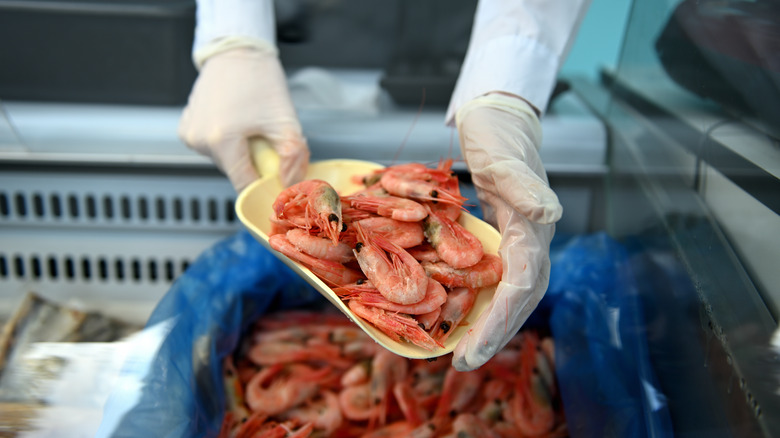The Toothpick Trick To Quickly Devein Shrimp
For a protein that can be pan-seared or flash-fried in a matter of minutes, shrimp takes a surprisingly long amount of time to prepare for cooking. One of the most important, yet tedious tasks is deveining — but it can be made much less time-consuming with a clever trick. Deveining a shrimp means removing its dorsal tract, commonly known as the back vein or sand vein. It's that dark line you spot on the backs of shrimp, and is actually the shellfish's stomach, midgut, and intestine.
Simply put, that black stuff is the shrimp's waste, so you'll definitely want to remove it! This task would normally require finicky knife work, but to make deveining a breeze, all you need is a toothpick. TikTok creator @patoisfood has even made a handy video demonstrating this method, in which the shells are left on for extra convenience.
@patoisfood There’s Always A Hack! #prawns #howto #patois #tiktokhow #cleaning #freshfish #seafood #food #chef #hack #devein #deveiningshrimp #canyouhelp #fyp
To try it, hold the shrimp by its tail end and look at the segments in its body. Deveining must start at the beginning of the last segment, right above the tail. At this segmented line, insert the toothpick just under the vein, which should only be about one or two millimeters into the shrimp. Gently pull the tip of the toothpick upward to hook the vein and pull it out. Now you can use your fingers to gently thread the rest of the vein out, and you're done. You can even use the same technique for frozen shrimp, as long as you let them completely thaw beforehand.
Deshelling shrimp in a few easy steps
You now know how to devein your shrimp like a pro, but prepping these shellfish doesn't end there. What about the shells and heads on whole shrimp? These parts don't necessarily need to be removed, and you can safely cook shrimp with the shells intact and remove it when you tuck in — in fact, some cooks say the shells add flavor.
Leaving the shell on is good for those who love the strong, seafood-y flavor it imparts. The shell also serves as a safeguard against overcooking by protecting the delicate flesh of the shrimp from direct heat, and providing a barrier against evaporation of its juices, leaving you with a more succulent result. Shelled shrimp can be hard to eat, however, as you'll need to peel all of them. For easy feasting, you can deshell your shrimp with a small pair of kitchen shears (the smaller the shears, the better, as this is a delicate job).
Simply use the shears to cut off the head, and then snip a line down the center of the shrimp's shell, making sure to cut no more than a ¼ inch into the shrimp. Once you've cut a line down to the tail, peel off the shell, legs and all. Don't discard that shell, though! You can repurpose shrimp shells and heads to make a deliciously flavorful seafood stock for shrimp étouffée and more.
Safety tips for buying shrimp
There are plenty of creative recipes for shrimp, but before you embark on a culinary adventure, choosing fresh shrimp is essential. No matter how thoroughly you prepare it, eating spoiled shrimp can cause all kinds of food poisoning due to bacteria like salmonella, E. coli, or vibrio. Ensuring your safety begins at the grocery store. You can assess the freshness of shrimp by checking the eyes, overall color, and shell.
Choose shrimp with intact and glossy eyes, and avoiding any with missing or shrunken ones. The shells should be firm and glossy as well. Fresh shrimp can come in a variety of hues, including white, pink, and brown, but some colors indicate spoilage. For example, black spots on the shell may indicate poor harvesting practices that impact food safety. Black spots can, however, naturally occur, so it's important to screen your shellfish for other signs of decomposition to tell if they're truly spoiled.
A quick sniff can also be revealing: Fresh shrimp has a subtle scent of seawater or seaweed. Reject shrimp with a rotten egg or ammonia smell, as these suggest the shrimp is well past its sell-by date. A strong chlorine odor is also a red flag, as chlorine is often used to mask the smell of spoiled shrimp. Shop responsibly and keep the right prep tips in mind, and you'll be on your way to cooking some smashing shrimps.



